
Guideway
Embodied Interaction & Accessible Design
Overview
Guideway, transforms outdoor tactile paving for indoor usage with sensory and textural feedback to prevent the problems that can disrupt a visitor’s museum experience. It is an integrative architectural solution based on embodied interaction and universal design principles. By using multi-sensory feedback, it helps visitors learn an exhibit’s intended flow and differentiate open/closed and what can be touched. Unlike other proposed solutions like wearable navigation aids, it allows visitors to maintain their focus on exhibits and installations.
Deliverables
Report
Duration
10 weeks
Microsoft Whiteboard, Figma, & Adobe Illustrator
Role
UX Researcher & Designer (solo project)
Tools
Process
DiscoverLiterature review
Remote observations
ExploreSketches
Storyboard
RefinePersonas
Journey maps
Revise
Updates: Storyboard & Concept model
DeliverReport with finalized concept designs
I synthesized findings from five publications to understand indoor wayfinding challenges, embodied wayfinding, and existing solutions from the perspective of museum visitors and staff. A common challenge was that existing solutions were often distracting. Wearables, mobile applications, and tablets focused interactions on devices instead of exhibits.
Background
Observations
To contextualize the challenges and better understand visit experiences, I conducted three in-direct observations using museum recordings and visitor vlogs featuring the Museum of Science & Industry, The Louvre, and the City Museum. I noted challenges, wayfinding strategies, tools, comments, and limitations.
* COVID-19 restricted in-person museum visits at the time of this project
Problem
Musuem staff need solutions that prevent distractions and guide visitors through exhibits. Museum visitors experience confusion and frustration when they are lost and unsure of how to interact or navigate with exhibits.
Flow: how should I move through an exhibit?
Access: Is this an area I can visit?
Interaction: Can I touch this?
Project Goals
To create an embodied solution that guides visitors, does not disrupt the experience, and blends with the museum environment.
Develop a sensory-based method of communicating an exhibit's intended flow.
Encourage interactions with displays made for touch.
Prevent guests from touching displays from being touched that should not be touched.
Prevent guests from accessing closed/under-construction exhibit rooms.
Design Principles
The seven principles of Universal Design informed my design process. I especially want to emphasize the following:
Equitable Use
Perceptible Information
Tolerance for Error
Personas & Journey Maps
Next, I developed three personas based on what I learned in the discovery phase and using John H. Falk's categorization of museum visitor identities. I expanded each journey map to capture experiences found during the discovery phase. The journey maps depict the current state to find opportunities for improvement.
Solution
What is Guideway?
Guideway is a multi-sensory flooring for indoor wayfinding. I was inspired by outdoor tactile paving that provides a number of movement indicators and hazard warnings. Guideway is unique because it provides a variety of interactions to communicate to a variety of users how to move through a space.
I created the design starting with sketches that explored the standard features of tactile paving, including specific textures for hazards and pause points. Additionally, the walkway tiles are textured to allow use for white canes but can easily be walked across or avoided if they prefer.
How It Works: Multi-sensory Interactions
A variety of cues were used as an accessibility consideration for a wide variety of users.
Physical: vibration & texture
Visual: light arrows
Sound: consonant & dissonant chords
Inspiration: outdoor tactile paving
Sketches to Finalized Concept Designs
Storyboard & Future Considerations
Initially, I created a storyboard to capture the ideal path and use of Guideway during sketching. After developing journey maps, I realized that the first interaction with Guideway in an exhibit might be jarring or unfamiliar. I updated the storyboard to include an onboarding process at the ticket kiosk so that users can experience all cues at the very start of the visit. In addition to protoyping and testing the flooring, exploring the kiosk interface would be the next step.
Version 1: the start of entering an exhibit and being guided through
verision 2: Updated to consider onboarding or training visitors
Mockups
I updated the final concept design to ensure consistency following the interaction model so that the warning sensory cues are uniform and consistent.
What worked: This project was primarily exploratory. I intended for Guideways to be a novel solution that explores embodied interactions and architecture for problem-solving. I wanted to challenge myself by thinking outside the box to consider designs beyond screens. One lesson I learned was the value of sketching and capturing negative experiences in journey maps and storyboards. If I had skipped this step, I would have missed the weaknesses in my design and misunderstood the opportunity to introduce users to how Guideways works early on.
What didn't: If I were to do this project again, I would incorporate methods that include potential users so that my design could be refined appropriately. For example, including users who are blind in either an interview or survey would provide data on whether Guideway is in line with tactile paving use and if the sensory feedback is helpful.







